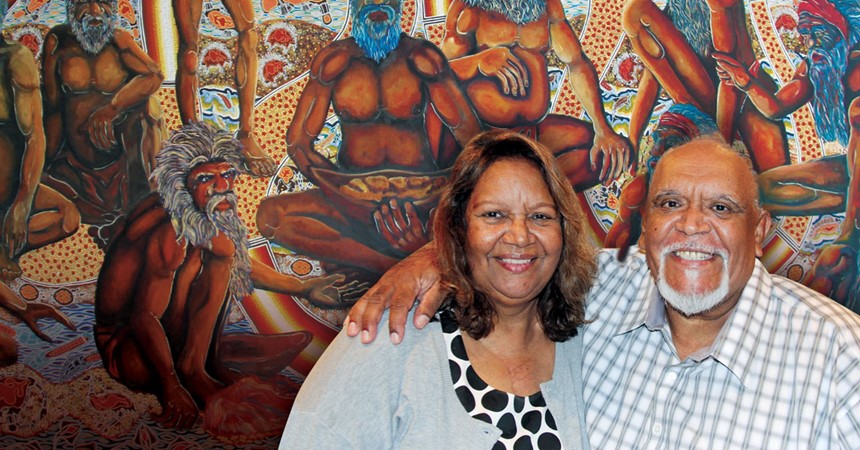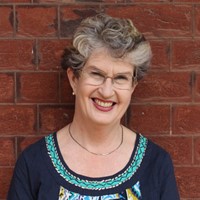Important symbols for brother and sister, Richard and Louise Campbell, are the gates that marked the entrance and exit to Kinchela Boys Home (KBH) outside Kempsey on the north coast.
It was where Louise and her sisters last saw Richard before he disappeared into the institution, aged 9 or 10, only emerging after many years of unbelievably and inexcusably cruel treatment. He remembers clearly that when he and his older brother (now deceased) “walked into the Kinchela gates, they grabbed you and stripped you, then they started punching you. They said, ‘You are not Richard Campbell, you are number 28 now. You are not black, you are white. You speak English and don’t talk about any Aboriginal stuff. They brainwashed us…they talk about the Holocaust. We’ve got it here too. They tried to get rid of a whole race of people.”
Many years later, Richard and three of his sisters, including Louise, returned to be photographed at the Kinchela gates and that photo’s a proud possession. “It’s a pretty significant symbol,” explains Louise, some 50 years after she was stolen from her parents. You might think this would be the last place the Campbells would want to preserve in memory. However, listening to Richard and Louise tell their stories – stories that ought to overlap far more than they do − it’s my sense that the photo is a talisman, offering evidence of survival against the odds.
Richard reminds me that there were 300 residential institutions in NSW at the time he was resident in Kinchela. Louise and her sisters were sent to a girls’ home at Bomaderry on the south coast but spent more time with foster families than at the home. The siblings belong to a family of 11 children and the youngest five are part of the Stolen Generation.
Their early childhood involved “going from town to town every year, to keep ahead of the welfare”. Richard says that in one town the Sisters at the convent would ring the bell to warn of approaching ‘welfare’.Eventually the Campbells joined the thousands of indigenous children taken from their parents, allegedly in their best interests. It’s impossible to measure the impact of being raised away from parents who love you, and it was only many years later that Richard and Louise realised that their Mum and Dad had no choice in the matter. While they were reunited with their parents, the relationships remained fractured.
Both Richard and Louise were eventually fostered by families. Louise had some positive experiences, Richard less so. Louise completed her schooling at St Joseph’s College, Lochinvar, and has happy memories of that time.
Asked when he left Kinchela, Richard says, “I don’t think I ever left institutions, it’s always in me.”
Two aspects of Richard’s life have rescued him from bitterness. Long ago, he realised, “My saviour was my artwork.” Before being stolen, he remembers drawing, on boomerangs and shields, designs his father would then burn into the timber. At Kinchela, he would draw wherever he could find a surface – and suffer the consequences. There was no paint and no encouragement but still Richard sketched.
Many years later, although Louise and Richard’s relationship has been sporadic, Louise found herself in a position to recommend Richard’s artistic talent to Sr Pat Adams rsm who has a long association with indigenous members of the diocesan community. She had seen paintings bearing the name ‘Richard Campbell’ at Mindaribba Gallery and wondered if the artist was her brother. This vignette highlights the immense loss all the Campbells suffered, including the older children who were not ‘stolen’.
Richard’s art led him to Fr Tony Stace and both he and Louise speak affectionately of the late diocesan priest. Fr Stace asked Richard to paint the annunciation and many scriptural paintings followed, notably the Stations of the Cross. In fact, Richard describes his years at Kinchela as a “painful, slow crucifixion”.
Many of Richard’s paintings hang in the diocesan offices and his distinctive and engaging work is in demand.
It’s a treat to listen to Louise and Richard converse. They have had to work hard to reclaim the stories most siblings share instinctively. Each is proud of the other’s achievements.
While art is integral to Richard’s survival, Louise credits education − she is a teacher − and a determination to remain occupied, for her ongoing wellbeing. Her position as Education Officer (Aboriginal Education) provides countless opportunities for her to share her story, individually and as a Gumbainggar woman, and to deepen her own knowledge and understanding. Underlying all this, she says, “The Church saved me…I feel I developed through the institution and through meeting some really good people through my life.”
Both Louise and Richard have aligned themselves to the work of Caritas Australia, especially Project Compassion. Richard is the focus of one of the Lenten stories, committing himself to share his story with various diocesan communities. In Newcastle, he shared his story in the first week of Lent with Louise not far away.
Art is a mainstay for Richard, and the other source of strength is his renewed acquaintance with the ‘Kinchela boys’ through the KBH Aboriginal Corporation (KBHAC), established by KBH survivors to reunite with one another and begin healing. KBHAC’s “Unlocking the Past to Free the Future” Program works to restore the social and emotional wellbeing of survivors and their families.
Initially, Richard was reluctant to become part of the program, although he freely admits that his early post-KBH years were marred by alcohol and drug use. He and the other boys had not been taught to respect themselves and to love others – they were physically, sexually and psychologically abused – so there were many memories he preferred not to retain. Eventually though, Richard, a father and grandfather, realised that the brotherhood of KBH boys could support and advocate for one another. He says, poignantly, “We had to create a country and we had to create a family.”
With the backing of Caritas Australia, KBHAC is helping to do so.
Meanwhile, Richard and Louise Campbell are gatekeepers who honour the past and maintain hope in a brighter future.
Please visit Caritas Australia.























































































